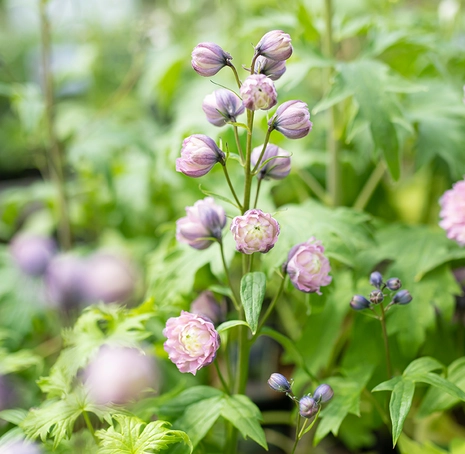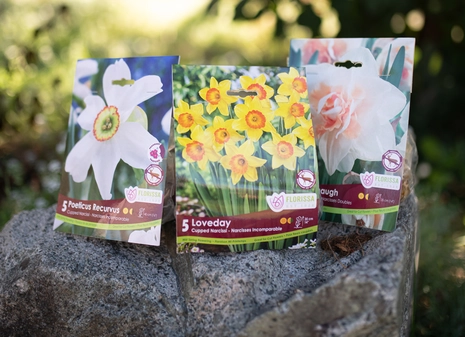Spring Bulbs
The glory of spring can be found in the blooming of bulbs. The stunning displays in gardens and parks are the result of gardeners who plan ahead. Late September is the time to begin, but if the soil is not frozen then they can be planted up to December, just in case you procrastinated.
Choosing and Planting Bulbs
With bulbs, it pays to get the best quality. Smaller, lower quality bulbs may be less expensive, but the effort of planning and planting is the same. The results are much more rewarding if top quality bulbs are planted as the flower is already formed and ready to go in the bulb. Then it’s up to you to give your bulbs a good start. Place a handful of bonemeal, or GardenWorks Bulb Food in the planting hole, to provide some long-lasting nutrients. Once the planting hole is filled in be sure to water thoroughly and regularly to encourage fast establishment before the onset of winter.
Bulbs can be planted anywhere in the garden, in sun or shade, naturalized in the lawn or in patio containers. They make an attractive show when planted under deciduous trees and shrubs as well as with ground covers such as pachysandra. Another idea is to plant winter blooming pansies, early flowering forget-me-nots or fragrant wallflowers with spring bulbs to provide an impressive show.
Bulbs are more impressive when they are planted in clusters rather than singly. Several bulbs planted together tend to give each other support and provide a more spectacular show. Small bulbs should be planted in groups of 15 to 25, and large bulbs in fives or tens.
Early Emergence
Don’t be worried if the bulb foliage pokes its head above the ground rather early. It has built-in insulation and can withstand quite a lot of cold. In the case of very hard, long frosts, mulch the area around the bulbs.
After-Flowering Care
After the flowers have faded, do not let seed pods form at the end of stems. The formation of seeds takes too much energy away from flower production for next year. Cut off the faded flower heads and leave the stem and foliage to die down naturally. Feed with GardenWorks Bulb Food after flowering. Bulbs are best left in the ground until they become overcrowded. When transplanting is necessary, wait until the foliage has died down and can be easily separated from the bulb. Remove as much soil as possible and store the bulb in a dry, well-ventilated place. Discard any diseased or old bulbs and replant the healthy-looking bulbs in the garden the following fall.
Small Bulbs
The following smaller sized bulbs should be planted 7.5 to 15cm (3 to 6”) apart, or nine to 16 bulbs per ft2.
Glory of the snow (Chionodoxa luciliae): Cheery pink or blue flowers with white centres appear in March. Plant this in drifts or clusters for the best effect.
Grape hyacinths (Muscari armeniacum): These quaint, clustered blooms are a spring delight. If left undisturbed, grape hyacinths will multiply over the years to form a glorious thick mat of foliage and flower. Flowers from March and into April.
Siberian squill (Scilla siberica): Squills bear long-last-ing blue blooms from February to March.
Snowdrop (Galanthus nivalis): Snowdrops begin to blossom in December and continue on into January. In mass plantings, they bring delicate beauty and fragrance to the winter landscape.
Spring crocus (Crocus ancyrensis, Crocus vernus): A multitude of colours can be found in the spring crocus group, from deep purples to yellows and white. Plant in drifts anywhere in the garden including the lawn.
Wind flower (Anemone blanda): Pink or white daisy-like flowers appear in February and March. Wind flowers will eventually colonize an area.
Winter aconite (Eranthis hyemalis): A low growing bulb with buttercup-like blooms in February. Wonderful bulb to naturalize in wooded areas.
Winter crocus (Crocus speciosus): These bulbs bear pink flowers in October and November. May be naturalized anywhere in the garden.
Large Bulbs
The following, larger sized bulbs should be planted approximately 15cm (6”) apart or nine bulbs per ft2.
Daffodils (Narcissus spp.): Daffodils are spring’s official announcement of the warmer days to come. Available in two-tone or traditional clear yellow as well as doubles, daffodils can be easily incorporated into any landscape. Dwarf varieties like ‘Jack Snipe’ are great in containers, and are strong enough to be naturalized in the lawn.
German iris (Iris germanica): Available in white and many shades of blue, purple and yellow. Dutch irises make excellent cut flowers, and bloom in May and June.
Hyacinth (Hyacinthus orientalis): Hyacinth blooms are pink, white or blue and can be seen in March and April. They are wonderful in window boxes, where the fragrance can waft indoors, as well as in any formal planting.
Tulips (Tulipa spp.): Available in many colours and sizes, tulips are one of the most identifiable bulbs in the garden. They are best planted in masses by keeping together groups with the same height and colour. Try naturalizing species tulips such as Tulipa kaufmanniana or Tulipa tarda in the rock garden. Depending on the type of tulip, the flowering time can be anywhere from March to May, so be sure to note the time of flowering in planning your spring display. Most tulip flowers last for two to three weeks.


